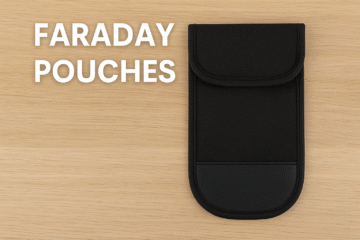RF Blocking Clothing Explained: Science, Benefits, and Everyday Uses
RF Blocking Clothing is emerging as a practical option for people looking to reduce their exposure to radiofrequency (RF) radiation from WiFi, cell towers, and connected devices. This guide explains why RF blocking clothing is needed, how it works, what products exist, and how to use it in daily life.
What Is RF Blocking Clothing?
RF Blocking Clothing (also called RF shielding or RF attenuating apparel) uses conductive fibers—often silver, copper, or stainless steel—woven into soft blocking fabrics that reflect or absorb electromagnetic waves. When worn, these garments help reduce how much radiofrequency energy reaches your body.
The goal isn’t perfect isolation. It’s balance: limiting unnecessary exposure while maintaining comfort and style.
🖼️ Image prompt: Close-up of a silver-thread RF blocking fabric sample under bright studio light.
🖼️ Image prompt: Person wearing an RF blocking hoodie while working on a laptop at home.
Why It’s Becoming Relevant
Wireless devices and 5G networks have made RF exposure nearly constant. While science continues to evaluate long-term health implications, many consumers adopt a precautionary approach—especially in bedrooms and home offices.
Common motivations include:
- Reducing nighttime exposure from routers and nearby electronics.
- Supporting wellness goals for individuals sensitive to electromagnetic environments.
- Lowering cumulative load from multiple sources such as smart meters, Bluetooth, and cell towers.
- Integrating wellness technology with daily wear instead of lifestyle disruption.
🖼️ Image prompt: Modern home with several wireless devices emitting soft signal waves; a person wears RF blocking clothing nearby.
The Science Behind RF Blocking Clothing
How It Works
RF blocking clothing functions like a flexible Faraday cage. Conductive fibers create a surface that redirects or absorbs radiofrequency waves.
- Incoming signals are reflected or converted into low-grade heat.
- The weave density, material conductivity, and coverage area determine performance.
- Independent lab tests often report attenuation levels in decibels (dB) showing how much signal reduction occurs across frequencies.
A peer-reviewed study found that certain knitted fabrics reduced electromagnetic radiation across the 100 MHz–1000 MHz range, depending on thread type and structure (PMC 7962651).
Scientific Considerations
- Coverage: More covered surface = higher attenuation.
- Fit: Loose or open seams allow signal penetration.
- Frequency range: Shielding may vary across WiFi, 4G, and 5G bands.
- Maintenance: Fabric integrity degrades if washed incorrectly.
- Testing: Look for published lab data and frequency charts.
🖼️ Image prompt: Diagram showing radio waves reflecting off a silver-thread fabric layer.
Popular RF Blocking Clothing Products
| Product | Description | Approx. Price | Merchant |
|---|---|---|---|
| SLNT Faraday Jacket & Pants Bundle | Full-body shielding set using conductive fibers for total coverage | ~$1,599 | slnt.com |
| Radia Smart Premium Shielding Poncho | Silver-thread poncho ideal for lounging or travel | ~$238 | Etsy – Radia Smart |
| Fusion Faraday Silver-Lined Pants | Breathable cotton pants with silver lining for partial body protection | ~$300 | Proteck’d Apparel |
| Mission Darkness EMF Blackout Hat | Lightweight RF blocking hat tested for cell and WiFi bands | ~$80 | mosequipment.com |
| SafeSleeve RF Blocking Beanie | Soft silver-fiber beanie for sleep or daily wear | ~$50 | safesleevecases.com |
| DefenderShield RF Blocking Cap | Everyday baseball-cap style shielding hat | ~$80 | defendershield.com |
| WOREMOR Silver Fiber Night Shirt | Nightwear for low-EMF sleep environments | ~$129 | emrss.com |
🖼️ Image prompt: Flat-lay of several RF blocking clothing items — hoodie, hat, leggings, and poncho — arranged neatly on a neutral background.
How to Incorporate RF Blocking Clothing into Daily Life
Practical Steps
- Identify high-exposure zones such as work desks, routers, or shared walls with smart meters.
- Select the right garment: ponchos or hoods for rest; jackets or caps for travel.
- Combine with other strategies: disable wireless functions at night, move devices away from the body, or use grounding accessories.
- Follow care instructions carefully — avoid bleach or high heat.
- Wear it consistently during higher-exposure activities.
Lifestyle Integration
RF blocking clothing fits best when it feels natural. Choose designs that blend with everyday outfits — not industrial gear — so protection becomes an easy habit rather than a chore.
🖼️ Image prompt: Person commuting in an RF blocking hoodie and cap, checking phone outdoors near a cell tower.
Common Mistakes to Avoid
- Expecting 100% isolation: No fabric blocks every signal. The goal is reduction, not elimination.
- Ignoring testing data: Choose products with published attenuation charts.
- Improper washing: Conductive threads can break down. Use gentle, cool wash cycles.
- Focusing on one area only: Covering head alone won’t protect torso; consider overall coverage balance.
- Over-reliance: Clothing complements environmental changes — it’s not a standalone fix.
Key Takeaways
- RF Blocking Clothing uses conductive fibers to reduce radiofrequency exposure by reflection or absorption.
- Its popularity grows as wireless density increases and people seek balanced, low-EMF lifestyles.
- Effectiveness depends on fabric composition, fit, frequency range, and coverage.
- Available options range from affordable beanies (~$50) to full-body suits (~$1,500).
- Combine wearables with environmental mitigation—distance, device management, and grounding—for best results.
References
- Pušić T. et al. “Electromagnetic Shielding Properties of Knitted Fabric for Protection Against Electromagnetic Radiation.” PMC 7962651.
- OSHA (1993). Interpretation Letter on RF Protective Clothing. osha.gov
- Safe Living Technologies – RF Shielding Fabric and Apparel Guide. safelivingtechnologies.com
- Less EMF – Shielding Fabrics and Textiles. lessemf.com
- HAVN Wear – Science Overview on EMF Exposure. havnwear.com


